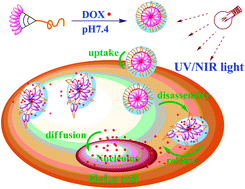Light-responsive linear-dendritic amphiphiles and their nanomedicines for NIR-triggered drug release†
Abstract
Both ultraviolet (UV) and near-infrared (NIR) light-responsive linear-dendritic amphiphiles, PEO-D3DNQ, were click conjugated by connecting the diazonaphthoquinone (DNQ)-decorated poly(amido amine) dendron D3 (generation 3) and linear poly(ethylene oxide) (PEO) with molecular weights of 2 or 5 kDa. They self-assembled into spherical micelles with a hydrophobic DNQ core stabilized by a hydrophilic PEO corona in aqueous solution. As characterized by time-resolved UV-vis spectroscopy, dynamic light scattering and TEM, these micelles showed both UV- and NIR-sensitivity in phosphate buffer solution. Under 365 nm UV irradiation, the characteristic absorption intensity of DNQ progressively decreased and then leveled off within 8 minutes, suggesting the completion of the Wolff rearrangement of DNQ, while it took a longer time of 40–60 minutes to complete the Wolff rearrangement of DNQ under 808 nm NIR irradiation. Most of the micelles were disrupted after 30 minutes of 808 nm irradiation, and the apparent drug-release rate of the doxorubicin (DOX)-loaded micelles showed a nearly 8-fold increase, presenting a NIR-triggered drug-release profile. The DOX-loaded micelles could quickly enter into HeLa cells, release DOX inside the cells, and then kill the cells in a NIR-triggered manner, as evidenced by flow cytometry, confocal laser scanning microscopy, and MTT assay.


 Please wait while we load your content...
Please wait while we load your content...